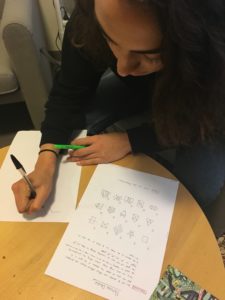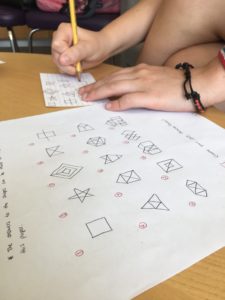Description
Pattern Doodle is a one player puzzle game where one must trace out as many as possible doodles in the least amount of time.
Pattern Doodle Shapes/Solutions
The player is presented with fifteen different doodles, one pencil, and one piece of paper. The objective of the game is to trace them all out without repeating a line or lifting the pen from the paper. The player can try drawing a doodle as many times as he/she wants, but is constrained by the time limit (usually fifteen minutes). The game will end once the player successfully manages to trace out the doodles or runs out of time.
*Most of the doodles presented in the game were invented by me, but a couple were taken from existing mind puzzle games.


Rules
1. Draw one shape at a time
2. Draw the shape without lifting the pen from the paper
3. Draw the shape without retracing a line
4. If you make a mistake, you can still continue to draw the pattern. Try as many times as you need
5. You have fifteen minutes to draw all fifteen shapes. Try to do as many as you can. You can skip shapes if you wish and come back to them later.
6. The game will end once the time runs out or you manage to trace all shapes!
Context of Play & SPACE
The game is bound by a piece of paper and the player. It is only the person, the paper, and the doodles. The game is purposely designed to let the mind wander around without any outside interference. There are no people, only two rules, three objects, and one winning condition.
Pattern Doodle can take place anywhere at anytime. All you need is pen an paper. Therefore, I believe the space is the paper. So, anywhere a player can find a paper, a player can play the game.
Playtest
Pattern Doodle was playtested with five different NYU Abu Dhabi students. They were presented with the description, the rules, a piece of paper, a pen, and the fifteen doodles.
The first two students received a different set of instructions than the last three. They were initially told to draw the fifteen doodles without a time constraint, but with a paper constraint. The game would end if they didn’t finish drawing the doodles in the amount of paper they were given.
As I observed their interaction with the game, I noticed that both students tried to form first the pattern in their heads because they had fear of making a mistake and running out of paper. Therefore, it wasn’t until they knew for sure how to draw the doodle without lifting the pen, that they would put it on the paper. This went against the idea of free doodling that I had initially discussed in class: mindless drawing.
This was not what I had originally intended, so I decided to change the rules. I gave the last three students as much paper as they needed, but gave them only fifteen minutes to draw the doodles. With this new rule change, the students drew more doodles without fear of making mistakes. This new game play was closer to what I had envisioned.



Creation vs. Destruction
Pattern Doodle invites creation because it forces people to explore different ways of drawing a doodle. When I playtested the game, I observed how players reached the same solution by moving the pen in different directions and starting points. The game allows users to create new solutions.
Expressiveness
This game brought a lot of emotions to those playing it. The wide range of expressions includes deep concentration when trying to strategist a doodle, relaxation when tracing the pattern on the paper, frustration when failing to get the doodle correct during any attempt, and satisfaction when finally succeeding to draw a pattern.
All the players that played the game experienced at least one of these emotions and was very expressive. I believe this is a good thing because it engages whoever is involved and allows them to get to know themselves better.
IN CLASS PLAYTESTING
I was able to play test the Pattern Doodle game once more during class time. I realized that the instructions were not as clear as I had believed earlier. My explanation was not as clear, possibly because we had so little time in class to play all games, and I rushed without allowing the players to know the exact rules. Instead of having the players draw one pattern at a time without lifting the pen up, two of the players thought they had to draw all patterns without lifting the pen up. After time was up, I was able to tell them what the actual rules and procedures were. As a result, I have made an update to the rules to make them much more clearer to the player (they can be found as an update to the post).